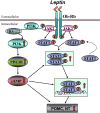A role of phosphodiesterase-3B pathway in mediating leptin action on proopiomelanocortin and neurotensin neurons in the hypothalamus
- PMID: 20471454
- PMCID: PMC2893383
- DOI: 10.1016/j.neulet.2010.05.018
A role of phosphodiesterase-3B pathway in mediating leptin action on proopiomelanocortin and neurotensin neurons in the hypothalamus
Abstract
Leptin signaling in the hypothalamus is required for normal food intake and body weight homeostasis. Recent evidence suggests that besides the signal transducer and activator of transcription-3 (STAT3) pathway, several non-STAT3 pathways mediate leptin signaling in the hypothalamus. We have previously demonstrated that leptin stimulates phosphodiesterase-3B (PDE3B) activity in the hypothalamus, and PDE3 inhibitor cilostamide reverses anorectic and body weight reducing effects of leptin. To establish the physiological role of PDE3B signaling in the hypothalamus, we examined if leptin signaling through the PDE3B pathway is responsible for the activation of proopiomelanocortin (POMC) and neurotensin (NT) neurons, which are known to play a critical role in energy homeostasis. To this end, we assessed the effect of cilostamide on leptin-induced POMC and NT gene expression in the rat hypothalamus. Results showed that while central injection of leptin significantly increased both POMC and NT mRNA levels in the medial basal hypothalamus, cilostamide completely reversed this effect of leptin suggesting a PDE3B-activation dependent induction of POMC and NT gene expression by leptin. This result further suggests that the PDE3B pathway plays an important role in mediating leptin action in the hypothalamus.
Copyright 2010 Elsevier Ireland Ltd. All rights reserved.
Figures


Similar articles
-
Hypothalamic Phosphodiesterase 3B Pathway Mediates Anorectic and Body Weight-Reducing Effects of Insulin in Male Mice.Neuroendocrinology. 2017;104(2):145-156. doi: 10.1159/000445523. Epub 2016 Mar 23. Neuroendocrinology. 2017. PMID: 27002827 Free PMC article.
-
Phosphatidylinositol 3-kinase is an upstream regulator of the phosphodiesterase 3B pathway of leptin signalling that may not involve activation of Akt in the rat hypothalamus.J Neuroendocrinol. 2013 Feb;25(2):168-79. doi: 10.1111/j.1365-2826.2012.02386.x. J Neuroendocrinol. 2013. PMID: 22967108 Free PMC article.
-
Phosphodiesterase-3B is expressed in proopiomelanocortin and neuropeptide Y neurons in the mouse hypothalamus.Neurosci Lett. 2011 Nov 14;505(2):93-7. doi: 10.1016/j.neulet.2011.09.068. Epub 2011 Oct 6. Neurosci Lett. 2011. PMID: 22001576 Free PMC article.
-
Intracellular leptin-signaling pathways in hypothalamic neurons: the emerging role of phosphatidylinositol-3 kinase-phosphodiesterase-3B-cAMP pathway.Neuroendocrinology. 2011;93(4):201-10. doi: 10.1159/000326785. Epub 2011 Apr 5. Neuroendocrinology. 2011. PMID: 21464566 Free PMC article. Review.
-
Leptin signaling in the hypothalamus: emphasis on energy homeostasis and leptin resistance.Front Neuroendocrinol. 2003 Dec;24(4):225-53. doi: 10.1016/j.yfrne.2003.10.001. Front Neuroendocrinol. 2003. PMID: 14726256 Review.
Cited by
-
Hypothalamic Phosphodiesterase 3B Pathway Mediates Anorectic and Body Weight-Reducing Effects of Insulin in Male Mice.Neuroendocrinology. 2017;104(2):145-156. doi: 10.1159/000445523. Epub 2016 Mar 23. Neuroendocrinology. 2017. PMID: 27002827 Free PMC article.
-
From PDE3B to the regulation of energy homeostasis.Curr Opin Pharmacol. 2011 Dec;11(6):676-82. doi: 10.1016/j.coph.2011.09.015. Epub 2011 Oct 14. Curr Opin Pharmacol. 2011. PMID: 22001403 Free PMC article. Review.
-
Phosphatidylinositol 3-kinase is an upstream regulator of the phosphodiesterase 3B pathway of leptin signalling that may not involve activation of Akt in the rat hypothalamus.J Neuroendocrinol. 2013 Feb;25(2):168-79. doi: 10.1111/j.1365-2826.2012.02386.x. J Neuroendocrinol. 2013. PMID: 22967108 Free PMC article.
-
Leptin signaling and its central role in energy homeostasis.Front Neurosci. 2023 Oct 31;17:1238528. doi: 10.3389/fnins.2023.1238528. eCollection 2023. Front Neurosci. 2023. PMID: 38027481 Free PMC article. Review.
-
HPRT-deficiency dysregulates cAMP-PKA signaling and phosphodiesterase 10A expression: mechanistic insight and potential target for Lesch-Nyhan Disease?PLoS One. 2013 May 14;8(5):e63333. doi: 10.1371/journal.pone.0063333. Print 2013. PLoS One. 2013. PMID: 23691025 Free PMC article.
References
-
- Al-Qassab H, Smith MA, Irvine EE, Guillermet-Guibert J, Claret M, Choudhury AI, Selman C, Piipari K, Clements M, Lingard S, Chandarana K, Bell JD, Barsh GS, Smith AJ, Batterham RL, Ashford ML, Vanhaesebroeck B, Withers DJ. Dominant role of the p110 isoform of PI3K over p110 in energy homeostasis regulation by POMC and AgRP neurons. Cell Metab. 2009;10:343–354. - PMC - PubMed
-
- Balthasar N, Coppari R, McMinn J, Liu SM, Lee CE, Tang V, Kenny CD, McGovern RA, Chua SC, Jr, Elmquist JK, Lowell BB. Leptin receptor signaling in POMC neurons is required for normal body weight homeostasis. Neuron. 2004;42:983–991. - PubMed
-
- Banks AS, Davis SM, Bates SH, Myers MG., Jr Activation of downstream signals by the long form of the leptin receptor. J Biol Chem. 2000;275:14563–14572. - PubMed
-
- Bates SH, Stearns WH, Dundon TA, Schubert M, Tso AW, Wang Y, Banks AS, Lavery HJ, Haq AK, Maratos-Flier E, Neel BG, Schwartz MW, Myers MG., Jr STAT3 signalling is required for leptin regulation of energy balance but not reproduction. Nature. 2003;421:856–859. - PubMed
Publication types
MeSH terms
Substances
Grants and funding
LinkOut - more resources
Full Text Sources
Research Materials
Miscellaneous

